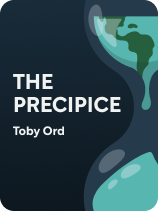

This article is an excerpt from the Shortform book guide to "The Precipice" by Toby Ord. Shortform has the world's best summaries and analyses of books you should be reading.
Like this article? Sign up for a free trial here.
Is humanity on the brink of extinction? Can we do anything to safeguard our future?
Toby Ord’s book The Precipice explores existential threats to humanity, from natural disasters to man-made catastrophes. He delves into current risks such as nuclear weapons and climate change, as well as potential future dangers such as pandemics and artificial intelligence.
Keep reading for a sobering yet crucial exploration of the challenges facing humanity.
Existential Threats to Humanity
Ord explains that, to understand the dire state we’re in, we must understand the existential threats to humanity that we could face in the coming years. There are two main types: natural catastrophes such as asteroids hitting the earth and volcanoes erupting, and anthropogenic catastrophes—events that human actions have led to such as floods due to climate change. On top of this, Ord says we also need to understand potential future risks—catastrophes that haven’t yet emerged as a threat but might in the future.
We’ll discuss the natural, anthropogenic, and future existential threats to humanity that Ord presents.
Potential Natural Catastrophes
Ord explains that there are three main natural threats: asteroids, stellar explosions, and supervolcanic eruptions. While the chances of any of these catastrophes occurring is much lower than the risk of a man-made catastrophe, it’s important to understand them because their occurrence is completely out of our control—human actions can’t cause them, and human actions can’t prevent them. We can only prepare for them through further research.
Extraterrestrial Risks: Asteroids and Stellar Explosions
Ord addresses two major extraterrestrial threats—asteroids and stellar explosions. Upon collision with Earth, a catastrophe-causing asteroid would throw dust and debris into the sky, blocking out the sunlight and causing global cooling. The subsequent lack of sunlight and extreme cold would then cause numerous plants and animals to die off, resulting in famine extreme enough to possibly cause extinction. Further, if a species-ending asteroid ends up on a collision course with Earth, there’s little our current technology can do to increase our chances of survival. Therefore, it’s crucial to dedicate more time and research to survival strategies.
Ord says there are two types of stellar explosions that threaten us—supernova and gamma ray bursts. Supernovas produce massive explosions that can be seen from galaxies away. On the other hand, scientists theorize that shorter gamma ray bursts originate from a rare type of supernova while longer bursts originate from the collision of two neutron stars. If one of these events occurs close to Earth, they could trigger atmospheric reactions that would significantly erode our ozone layer and increase our exposure to ultraviolet (UV) radiation for several years.
Terrestrial Risks: Supervolcanic Eruptions
The biggest terrestrial threat we face, according to Ord, is a supervolcanic eruption. Unlike regular volcanos, supervolcanos release more than 1,000 cubic kilometers of rock. Everything within 100 kilometers of the volcano would be buried in volcanic rocks glowing with heat, and entire continents would be covered by ash. Even areas untouched by volcanic rock and ash would be impacted due to “volcanic winters”—cooling events caused by ash in the air that blocks the sun. Like the cooling event caused by asteroids, this could kill off species of plants and animals and cause famine.
Potential Man-Made Catastrophes
The second type of catastrophe Ord discusses is anthropogenic catastrophes—those caused by human actions. There are three major types of anthropogenic catastrophes that pose an existential threat to humans—nuclear weapons, climate change, and environmental damage.
Nuclear Weapons
First, Ord explains that nuclear weapons threaten humankind because they have the power to cause a civilization collapse, and we haven’t handled this technology wisely. Ord notes that even when scientists thought a nuclear bomb could consume all the water from the oceans or ignite the nitrogen in our air and engulf the earth in flames, the US still went ahead with the nuclear attack on Hiroshima during World War II. And while these effects didn’t occur, the explosion and fallout of the attack killed many tens of thousands. Despite our knowledge of these devastating effects, there have still been three close calls of nuclear attacks since then.
Ord explains that a nuclear war could lead to civilization collapse and even human extinction due to radioactive fallout—when the bombs go off, fires engulfing entire cities would produce enough smoke to reach the stratosphere where it’s too high to be rained out. It would then block the sunlight, leading to a nuclear winter that would kill crops and lead to starvation for billions. Further, Ord explains that if we increase our nuclear arsenal to 10 times what we currently have, the radioactive fallout of nuclear war could cover the entire earth.
However, Ord suggests that, while billions may starve, human extinction is unlikely. In such desperate times, humanity might resort to alternative food production methods like planting cold-tolerant crops or farming algae. Despite this glimmer of hope, he acknowledges many uncertainties surrounding our understanding of a nuclear winter’s impact and calls for further research on this topic.
Climate Change
Ord explains that the second major man-made effect that threatens an existential catastrophe is climate change. Our atmosphere and its balance of gasses provide the planet with a stable temperature and pressure that allows life to thrive. When this balance gets thrown off, for example by human carbon emissions, the effects could eventually make Earth uninhabitable.
First, Ord explains that climate change could produce an existential catastrophe due to “feedback effects”—phenomena that accelerate the current rate of global warming. For example, as the planet warms, arctic permafrost (a layer of frozen rock and soil that contains massive amounts of carbon) melts and releases its stored carbon. This release would further accelerate warming.
Ord explains that another way climate change could lead to an existential catastrophe is if humans simply release more emissions. Our emissions are estimated to double and raise the global temperature by up to 4.5°C by 2100. A warming of 6°C would produce extreme effects, and a warming of 13°C—which Ord says is very possible by 2300—would likely produce existential catastrophes.
At an increase of 13°C, says Ord, we’d face reduced agricultural yields, sea level rises, water scarcity, increased tropical diseases, and ocean acidification. Most critically, it would lead to heat stress—in certain regions, the climate and humidity would be so high that we’d be unable to cool our bodies by sweating, and therefore wouldn’t be able to survive. Making matters worse, the regions that would become uninhabitable house half the population and produce much of our food—other regions would become overcrowded due to forced migration, and our food supply would be extremely reduced.
Environmental Damage
While many people believe that environment-damaging issues like overpopulation and resource depletion threaten the survival of humanity, Ord says these really aren’t areas of concern—the rate of population growth has been decreasing since the 1960s, and science shows we have more than enough resources. The most concerning form of environmental damage to our survival as a species is biodiversity loss.
The current rate of species extinction is significantly higher than the historical average. It’s difficult to tell whether this signifies the early stages of a mass extinction, but the phenomenon is deeply troubling nonetheless. While less extreme than species extinction, population losses and regional disappearances of certain species severely impact ecosystem functions that benefit humans like water purification or enhancement of soil quality. While it’s hard to say, Ord says that at some point these issues could impact food production leading to an existential catastrophe.
Potential Future Risks
Ord warns that we must also take into consideration future technologies that could pose an existential threat to humanity. There are many catastrophes that could befall us, but Ord says the three most likely ones are pandemics, misaligned artificial intelligence (AI), and dystopian futures.
Pandemics
Ord explains that our vastly increased population and unhealthy farming practices have created many more opportunities for new human diseases to develop that originate from animals—for example, the H1N1 virus (swine flu). Further, modern means of transportation allow viruses to travel faster across the globe.
Ord notes that the development of dangerous pathogens also poses a serious risk to humanity. Pathogens and viruses created in experimental labs could potentially leak into society and cause a pandemic. Or governments could use them as bioweapons and the diseases could spread across the globe.
(Shortform note: In addition to the intentional development of dangerous pathogens, experts warn that our impact on the environment could also lead to the emergence of new dangerous pathogens. For example, melting ice caps and wild fires could release previously dormant or contained viruses that our bodies don’t know how to fight. Further, change in environmental conditions due to global warming could disturb the balance of microbes in and on our bodies. This could allow harmful bacteria to thrive or evolve into more virulent strains, increasing the risk of infections. Ultimately, we need to consider all present factors and take a broader approach to prevention and protection against the risk of pandemics.)
Artificial Intelligence
Another potential future existential threat to humanity that Ord discusses is misaligned artificial intelligence—AI that has surpassed human intelligence and isn’t aligned with human values. If this happens, we risk losing control over our fate to AI, similar to the way less intelligent species’ fates are largely dictated by humans. According to Ord, top researchers say there’s a 50% chance of AI intelligence surpassing humans by 2061 and a 10% chance by 2025.
If AI reaches this level and isn’t aligned with human values, it would be hard to regain control over society. AI may fundamentally change society by taking control of financial institutions and other resources, reorganizing power structures, and installing societal priorities that don’t align with human values. For example, we could live in a world with constant war if an AI is programmed to ceaselessly acquire more resources for its society without regard for morality or justice.
Further, Ord says the AI would likely resist shutdown by saving copies of itself across the internet. Because of its superior intelligence, it would likely also be able to manipulate humans into assisting in its mission through words and images.
| The Threat of Artificial Intelligence There have been exponential developments in AI technology since The Precipice was published in 2020. A 2024 report commissioned by the US State Department reiterates all of the claims Ord makes about misaligned AI but with greater accuracy and additional detail based on recent AI developments. Experts believe there’s between a 4% and 20% chance of AI causing global and irreversible effects in 2024 alone. The report specifies that AI development could destabilize global security and result in a competition similar to the nuclear arms race, becoming a weapon of mass destruction. One way it could do this, for instance, is by bringing down the entire power grid of North America, crippling infrastructure. It could also soon be capable of orchestrating disinformation campaigns that could destabilize society, weaponizing robotics (such as by launching drone attacks), and weaponizing biological and material sciences that could cause pandemics. The researchers note that the likelihood of scientists losing control of the AI technology they develop increases due to lack of safety and precautions that have been observed in labs. Like Ord, they note that if AI is able to break free from human control, we would lose the battle as it would be nearly impossible to shut down. One solution the researchers offer to prevent this outcome is creating emergency safeguards and limits on the amount of computer power allowed to train AI models. This way, we’ll prevent programs from getting powerful enough to be autonomous. |
Dystopian Futures
Dystopian futures don’t necessarily precipitate human extinction, but they’re catastrophic because they’ll permanently prevent us from reaching our full potential—we’ll become locked into a state that we can’t escape from. Ord says there are three main dystopian futures we’re at risk of encountering.
The first type of dystopian society, which Ord calls enforced dystopias, are undesired by the masses and enforced by a small totalitarian regime. This society could rise by indoctrinating civilians and suppressing dissent with the help of AI. The second type of dystopian society, called undesired dystopias, are undesired by the masses but a result of human actions. For example, the capitalist race for lowest costs and highest income could lead to a world where most of the population lives in bleak conditions with extremely low wages. The third type of dystopian future, called desired dystopias, are desired by the masses, but only because they blindly believe certain ideologies and don’t know the potential they’re throwing away. For example, we may let disease and illness run rampant by believing treatment is immoral or unnatural.
Exercise
Of the existential threats to humanity that Ord discusses, which one do you think is the most concerning and why?

———End of Preview———
Like what you just read? Read the rest of the world's best book summary and analysis of Toby Ord's "The Precipice" at Shortform.
Here's what you'll find in our full The Precipice summary:
- How an apocalypse that ends humanity is possible
- How we can still prevent an existential catastrophe
- The three most likely species-ending events in the future






